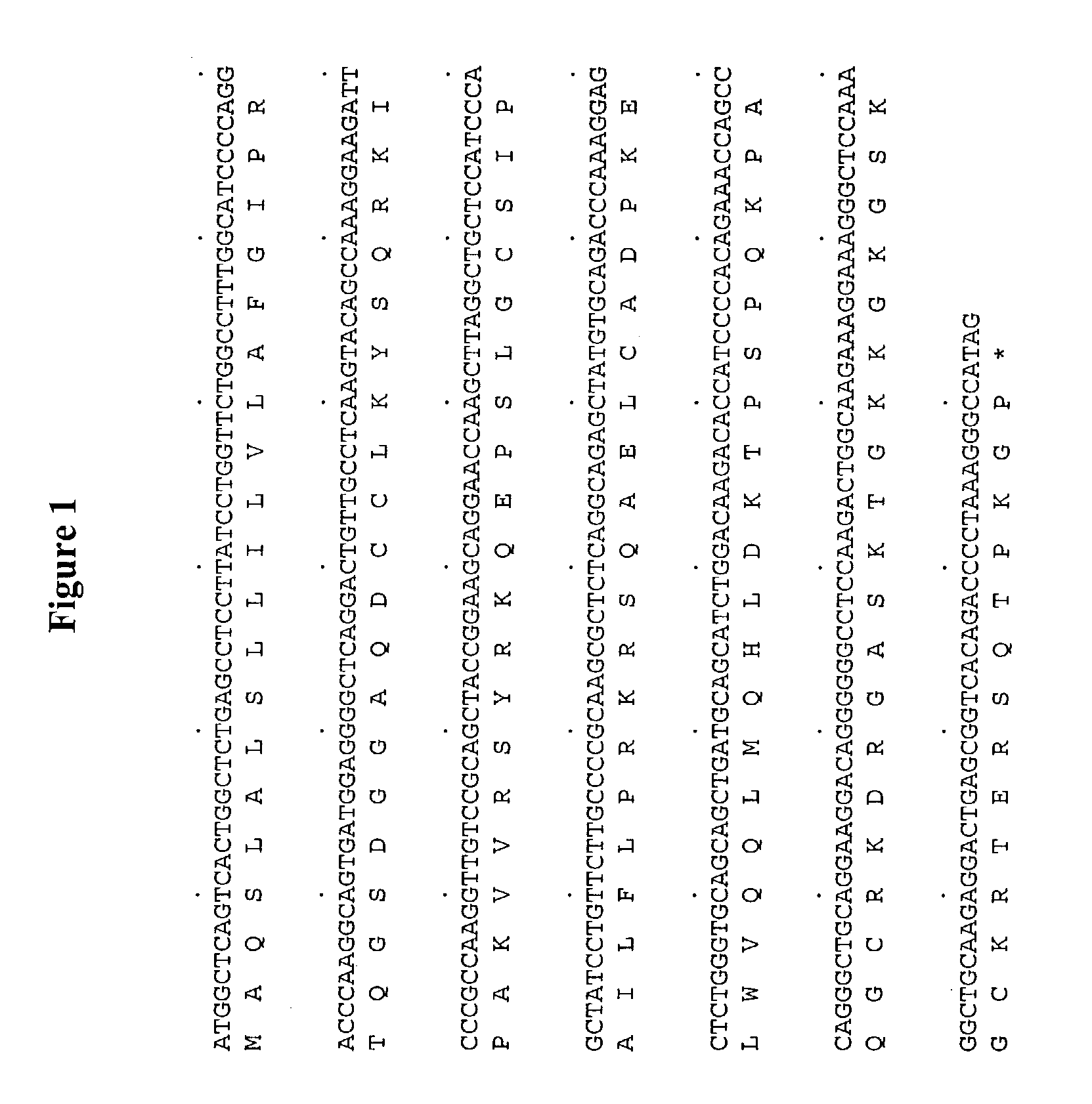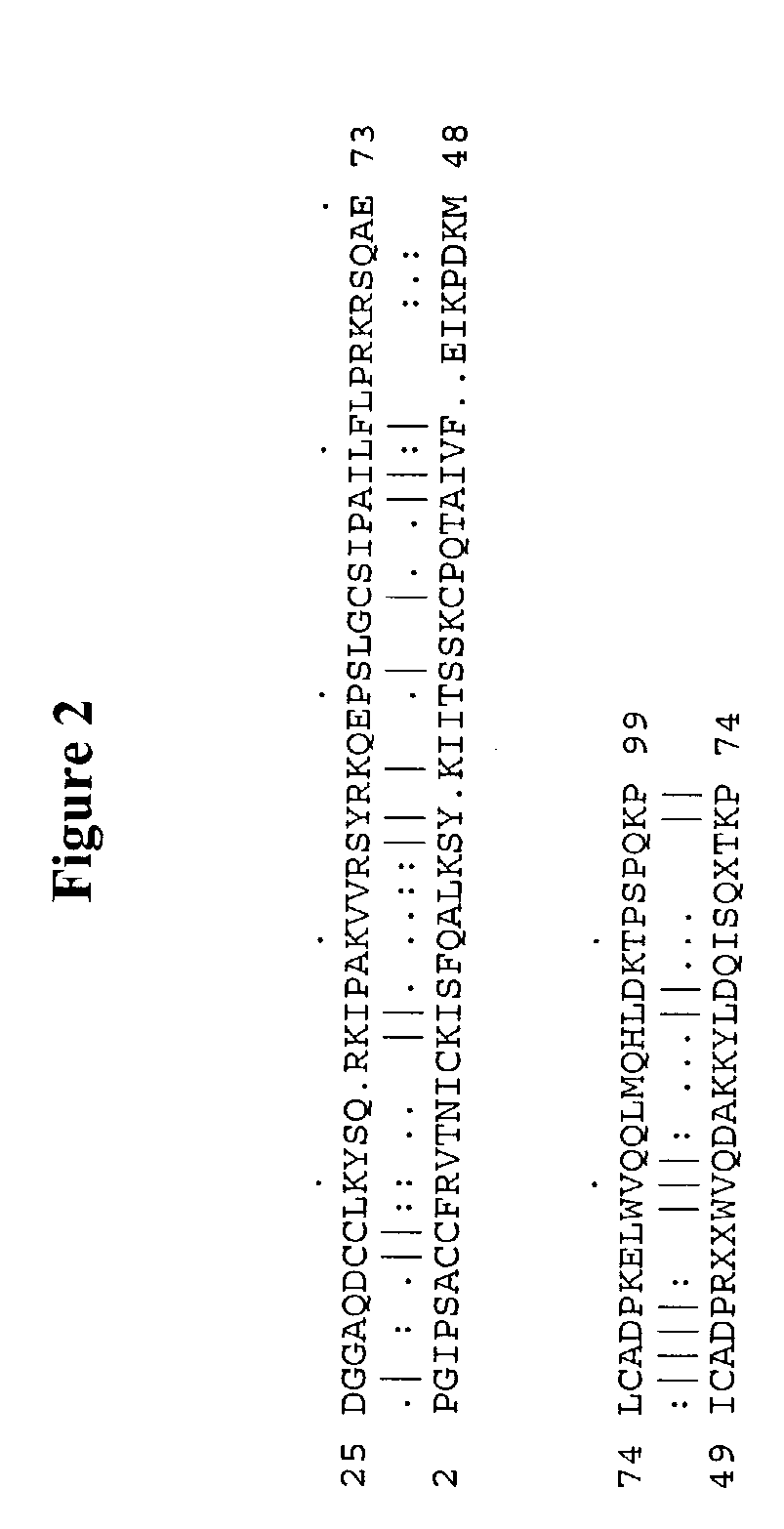Antibodies to human chemokine beta-9
a technology of chemokine beta-9 and antibodies, which is applied in the field of newly identified polynucleotides and polypeptides, can solve the problem of not being able to attach a precise role to the members of the branch, and achieve the effect of promoting wound healing
- Summary
- Abstract
- Description
- Claims
- Application Information
AI Technical Summary
Benefits of technology
Problems solved by technology
Method used
Image
Examples
example 1
Bacterial Expression and Purification of Ckβ-9
[0131] The DNA sequence encoding for Ckβ-9, ATCC # 75803, is initially amplified using PCR oligonucleotide primers corresponding to the 5′ and 3′ end sequences of the processed Ckβ-9 gene (minus the putative signal peptide sequence). Additional nucleotides corresponding to Ckβ-9 were added to the 5′ and 3′ end sequences, respectively. The 5′ oligonucleotide primer has the sequence 5′ CCCGCATGCGTGATGGAGGGGCTCAG 3′ (SEQ ID NO:3) contains a SphI restriction enzyme site (bold) followed by 17 nucleotides of Ckβ-9 coding sequence (underlined) starting from the second nucleotide of the sequences coding for the mature protein. The ATG codon is included in the SphI site. In the next codon following the ATG, the first base is from the SphI site and the remaining two bases correspond to the second and third base of the first codon (residue S24) of the putative mature protein. As a consequence, the first base in this codon is changed from A to C c...
example 2
Expression of Recombinant Ckβ-9 in COS cells
[0132] The expression of plasmid, Ckβ-9 HA is derived from a vector pcDNAI / Amp (Invitrogen) containing: 1) SV40 origin of replication, 2) ampicillin resistance gene, 3) E. coli replication origin, 4) CMV promoter followed by a polylinker region, a SV40 intron and polyadenylation site. A DNA fragment encoding the entire Ckβ-9 precursor and a HA tag fused in frame to its 3′ end is cloned into the polylinker region of the vector, therefore, the recombinant protein expression is directed under the CMV promoter. The HA tag corresponds to an epitope derived from the influenza hemagglutinin protein as previously described (I. Wilson, H. Niman, R. Heighten, A Cherenson, M. Connolly, and R. Lerner, 1984, Cell 37, 767). The infusion of HA tag to the target protein allows easy detection of the recombinant protein with an antibody that recognizes the HA epitope.
[0133] The plasmid construction strategy is described as follows:
[0134] The DNA sequenc...
example 3
Expression Via Gene Therapy
[0135] Fibroblasts are obtained from a subject by skin biopsy. The resulting tissue is placed in tissue-culture medium and separated into small pieces. Small chunks of the tissue are placed on a wet surface of a tissue culture flask, approximately ten pieces are placed in each flask. The flask is turned upside down, closed tight and left at room temperature over night. After 24 hours at room temperature, the flask is inverted and the chunks of tissue remain fixed to the bottom of the flask and fresh media (e.g., Ham's F12 media, with 10% FBS, penicillin and streptomycin, is added. This is then incubated at 37° C. for approximately one week. At this time, fresh media is added and subsequently changed every several days. After an additional two weeks in culture, a monolayer of fibroblasts emerge. The monolayer is trypsinized and scaled into larger flasks. [0136] pMV-7 (Kirschmeier, P. T. et al, DNA, 7:219-25 (1988) flanked by the long terminal repeats of t...
PUM
| Property | Measurement | Unit |
|---|---|---|
| diameter | aaaaa | aaaaa |
| body weight | aaaaa | aaaaa |
| pH | aaaaa | aaaaa |
Abstract
Description
Claims
Application Information
 Login to View More
Login to View More - R&D
- Intellectual Property
- Life Sciences
- Materials
- Tech Scout
- Unparalleled Data Quality
- Higher Quality Content
- 60% Fewer Hallucinations
Browse by: Latest US Patents, China's latest patents, Technical Efficacy Thesaurus, Application Domain, Technology Topic, Popular Technical Reports.
© 2025 PatSnap. All rights reserved.Legal|Privacy policy|Modern Slavery Act Transparency Statement|Sitemap|About US| Contact US: help@patsnap.com


